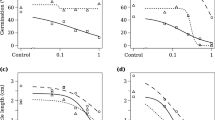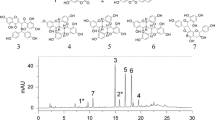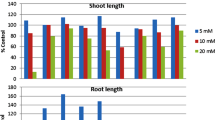Abstract
In a previous study, lavender (Lavandula spp.) was found to be highly phytotoxic towards annual ryegrass (Lolium rigidum, ARG), a major weed of winter wheat crops in Australia. This research aimed to further explore this relationship and determine the chemical(s) responsible for the observed effect. In bioassay, it was determined that the stem and leaf extract of L. x intermedia cv. Grosso ranked highest and had the potential to reduce significantly the root growth of several plant species. An extract concentration of 10% almost completely inhibited ARG root growth. When the extract was tested for stability, there was no loss in phytotoxicity after the 256 day trial. Via bioassay-guided fractionation and chromatographic techniques, it was determined that the sub-fraction consisting of coumarin and 7-methoxycoumarin was most phytotoxic towards ARG. Chemoassays of 18 structural analogues of coumarin showed that coumarin itself was the most phytotoxic and largely responsible for the observed phytotoxicity of the extract. Soil trials were conducted using pure coumarin and the lavender extract, and in both instances, shoot length and weight were significantly reduced by post-emergence application at all concentrations evaluated.





Similar content being viewed by others
References
Aburjai, T., Hudiab, M., and Cavrini, V. 2005. Chemical composition of the essential oil from different aerial parts of lavender (Lavandula coronopofolia Poiert) (Lamiaceae) grown in Jordan. J. Ess. Oil Res. 17:49–51.
Angioni, A., Barra, A., Coroneo, V., Dessi, S., and Cabras, P. 2006. Chemical composition, seasonal variability, and antifungal activity of Lavandula stoechas L. ssp stoechas essential oils from stem/leaves and flowers. J. Agric. Food Chem. 54:4364–4370.
Areias, F. M., Valentao, P., Andrade, P. B., Moreira, M. M., Amaral, J., and Seabra, R. M. 2000. Hplc/Dad analysis of phenolic compounds from lavender and its application to quality control. J. Liquid Chrom. Related Tech. 23:2563–2572.
Argyropoulos, E. I., Eleftherohorinos, I. G., and Vokou, D. 2008. In vitro evaluation of essential oils from Mediterranean aromatic plants of the Lamiaceae for weed control in tomato and cotton crops. Allelopathy J. 22:69–78.
Avers, C. J., and Goodwin, R. H. 1956. Studies on roots IV. Effects of coumarin and scopoletin on the standard root growth pattern of Phleum pratense. Amer. J. Bot. 43:612–620.
Broster, J. C., and Pratley, J. E. 2006. A decade of monitoring herbicide resistance in Lolium rigidum in Australia. Aus J. Exp. Ag. 46:1151–1160.
Chon, S. U., and Kim, Y. M. 2004. Herbicidal potential and quantification of suspected allelochemicals from four grass crop extracts. J. Agron. Crop Sci. 190:145–150.
Cornes, D. 2005. Callisto: a very successful maize herbicide inspired by allelochemistry, pp. 569–572, in J. D. I. Harper, M. An, H. Wu, and J. H. Kent (eds.). Proceedings of the 4th World Congress on Allelopathy. Charles Sturt University, Wagga, Australia.
Dias, L. S., Pereira, I. P., and Dias, A. S. 1995. Evaluation of Mediterranean-type vegetation for weedicide activity. Allelopathy J. 2:197–204.
Dias, A. S., Dias, L. S., and Pereira, I. P. 2004. Activity of water extracts of Cistus ladanifer and Lavandula stoechas in soil on germination and early growth of wheat and Phalaris minor. Allelopathy J. 14:59–64.
Dornbos, D. L., and Spencer, G. F. 1990. Natural products phytotoxicity—A bioassay suitable for small quantities of slightly water-soluble compounds. J. Chem. Ecol. 16:339–352.
Goodwin, R. H., and Taves, C. 1950. The effect of coumarin derivatives on the growth of Avena roots. Amer. J. Bot. 37:324–331.
Haig, T., Pratley, J., An, M., Haig, T., and Hildebrand, S. 2005. Using allelopathy to search for new natural herbicides from plants, pp. 565–568, in J. D. I. Harper, M. An, H. Wu, and J. H. Kent (eds.). Proceedings of the 4th World Congress on Allelopathy. Charles Sturt University, Wagga, Australia.
Moon, T., Wilkinson, J. M., and Cavanagh, H. M. A. 2006. Antiparasitic activity of two Lavandula essential oils against Giardia duodenalis, Trichomonas vaginalis and Hexamita inflate. Parasitology Res. 99(6):722–728.
Moon, T., Cavanagh, H. M. A., and Wilkinson, J. M. 2007. Antifungal activity of Australian grown Lavandula spp. essential oils against Aspergillus nidulans, Trichophyton mentagrophytes, Leptosphaeria maculans and Sclerotinia sclerotiorum. J. Ess. Oil Res. 19:171–175.
Papachristos, D. P., and Stamopoulos, D. C. 2004. Fumigant toxicity of three essential oils on the eggs of Acanthoscelides obtectus (Say) (Coleoptera: Bruchidae). J. Stored Prod. Res. 40:517–525.
Pavela, R. 2005. Insecticidal activity of some essential oils against larvae of Spodoptera littoralis. Fitoterapia 76:691–696.
Pergo, E. M., Abrahim, D., Da Silva, P. C. S., Kern, K. A., Da Silva L. J., Voll, E., and Ishii-Iwamoto, E. L. 2008. Bidens pilosa l. Exhibits high sensitivity to coumarin in comparison with three other weed species. J. Chem. Ecol. 34:499–507.
Qasem, J. R. 2002. Allelopathic effects of selected medicinal plants on Amaranthrus retroflexus and Chenopodium murale. Allelopathy J. 10:105–122.
Roller, S., Ernest, N., and Buckle, J. 2009. The antimicrobial activity of high-necrodane and other lavender oils on methicillin-sensitive and -resistant Staphylococcus aureus (MSSA and MRSA). J. Alt. and Comp. Med. 15:275–279.
Romeo, F. V., De Luca, S., Piscopo, A., and Poiana, M. 2008. Antimicrobial effect of some essential oils. J. Ess. Oil Res. 20:373–379.
Salido, S., Altarejos, J., Nogueras, M., Sanchez, A., and Luque, P. 2004. Chemical composition and seasonal variations of spike lavender oil from southern Spain. J. Ess. Oil Res. 16:206–210.
Tiliacos, C., Gaydou, E. M., Bessiere, J. M., and Agnel, R. 2008. Distilled lavandin (Lavandula intermedia emeric ex loisel) wastes: A rich source of coumarin and herniarin. J. Ess. Oil Res. 20:412–413.
Uremis, I., Arslan, M., and Sangun, M. K. 2009. Herbicidal activity of essential oils on the germination of some problem weeds. Asian J. Chem. 21:3199–3210.
Acknowledgements
Sincere thanks go to Dr. Nigel Urwin for supplying the plant material and to David Waters, Shane Hildebrand and the late Kim Ashton who assisted with plant collection and processing. The authors also thank the Australian Research Council (ARC) for financial support.
Author information
Authors and Affiliations
Corresponding author
Rights and permissions
About this article
Cite this article
Haig, T.J., Haig, T.J., Seal, A.N. et al. Lavender as a Source of Novel Plant Compounds for the Development of a Natural Herbicide. J Chem Ecol 35, 1129–1136 (2009). https://doi.org/10.1007/s10886-009-9689-2
Received:
Revised:
Accepted:
Published:
Issue Date:
DOI: https://doi.org/10.1007/s10886-009-9689-2




